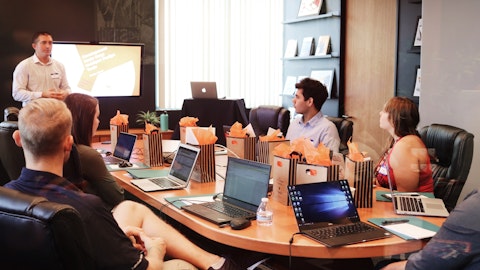James Lico: Yes. We experienced a network infrastructure disruption from what we’re calling a cyber-incident in the quarter. We talked about some costs to mitigate that, roughly $0.01, around $5 million that’s in the guide. That’s what we called out. We did have some downtime in some North American facilities. Those are back up and running. We definitely think we can mitigate that. We’ve mitigated the issues relative — we have first contained the issues. We’ve mitigated them. We’ve completed the investigation. We’re implementing the final remediation measures. So we don’t believe this incident has a material impact on the quarter. So that’s where we stand.
Jeffrey Sprague: Right, thank you.
Operator: Your next question comes from the line of Deane Dray from RBC Capital Markets. Please go ahead.
Deane Dray: Thank you. Hi, everyone. Can we start with the EA acquisition? One of the things that struck me in the release is you talked about how you want to leverage the Tektronix franchise. And maybe just kind of elaborate on that. Is it distribution? Looking at their products, there’s a lot of kind of similarities in terms of benchtop, but it doesn’t seem to me there’s a lot of product application overlap and maybe I’m wrong there. So how does the leveraging the Tek franchise play out here?
James Lico: Yes. There’s not a lot of product overlap, Deane, you’re right, but there is a bunch of application overlap. We’ve talked about the power market at Tek for a number of and how that’s really been driving growth even in the quarters we were just describing, we continued to see strength. And that’s really been on the backs of our mainstream oscilloscopes and probes and our sourced measuring units. And almost in every one of those applications is also an EA-type product, if you will. So we will 10x their go to market. They were mostly direct in Germany and parts of Europe, mostly with distributions in countries around the world. We’ll 10x that with our own go-to-market from a capability, both direct and channel capability.
We think that’s a tremendous leverage point. It is at the call point we’re at and we see a lot of those applications relative to seeing EA right there in many cases or, in many cases, seeing others and understanding that we can be a partner to EA in that regard relative to the go-to-market. So we feel good about the synergies. It’s obviously a very good business. It’s had very strong growth. It’s got software like growth and software-like margins. And we think we can really help accelerate the continued market expansion of the product lines.
Deane Dray: Great, that’s good to hear. And then just as a follow-up in some of the themes about what are you seeing that might be recessionary or not, two areas I’d be interested in hearing, the typical Fluke sell-in versus sell-through, how that is the cadence there? And then broadly, the cadence for the quarter, if you broke out revenue growth or orders, how did it play out in the quarter by month? And did you exit in a more deteriorating fashion or not?
James Lico: Yes. I mean, I think when we look at Fluke POS, as an example, in North America is probably the best place to think about the U.S. economy. It played out pretty consistently, although point of sale came in pretty consistently. We got to look at 2-year stacks because as we fulfill backlog over the last 12 to 18 months, it does in some respects, distorted a little bit. But by and large, pretty consistent. I think when we looked at China, it was probably a little slower as we got — as we went through. But I think we have a good understanding of where that was and that kind of thing, and that’s broadly China, not just Fluke. So I would say that’s how anticipate it. Tek, on the other hand, was their order growth was actually better in September than it was through the early part of the quarter.
I would say, though, we did see a little bit later in the month. And so there was maybe a little bit of a dynamic where in a few places. But I think that’s really what — the biggest change in really how we think about the second half, though, is really coming back to less, maybe really specific OEM customers within Sensing in those markets I described and China. I think those are the 2 big changes that we really saw.
Deane Dray: Great. Thank you.
James Lico: Thank you.
Operator: Your next question comes from the line of Andrew Obin from Bank of America. Please go ahead.
Andrew Obin: I guess a question on PT and the decision to sort of buy EA. I think for years and we’ll have Tek. But it was like one of the acquisitions back at Danaher, this is the one that didn’t go well. And there were questions and all of a sudden, there’s a lot of attention being paid to it, right? Press report at NATI, clearly, you’re making a bet here with EA. Can you just talk about the evolution of the company’s thinking about sort of Tek and how you’re thinking about the business overall? Where this is all of a sudden a key area for capital deployment? And what it is you’re seeing two, three years down the road that gets you excited?
James Lico: Yes. Thanks, Andrew. I would say, number one, when you look at the returns of Tek from back a while ago, those returns are good, no. Yes, we had a little bit of challenge in the early days. That’s exactly right, but that’s a little bit of old tape. The returns now are good. And I think we feel good about the business. And I think the performance in the business over the last several years and the profitability that’s come with that has been very good because of the strategy of getting out of some businesses that were much more volatile, the video business being one of them but a few others, getting into more services, which gives us a higher attach rate and less volatility. And you’ve seen that play out over the last couple of years.
I think as a large business within the company, we’ve been very specific. And we think we’ve been very deliberate in terms of our narrative that the power market was a very good market for us. It had good trajectories relative to secular drivers around electrification. That’s not just EVs. Sometimes, people think of that as mobility. That’s much more around storage. It’s much more around the use of renewable energy and the challenges that, that brings to the grid, the challenge it brings to data centers, the challenge it brings on storage. And we’ve got an exceptional — we’ve had exceptional success in those markets over the last few years. We talk about that relative to our own success as the mainstream oscilloscope line in that platform and the success that, that’s had.
So a natural extension of that is what we see at EA. And that’s an opportunity for us to have a high-value bolt-on. It accretes immediately to Tektronix’ growth rate and profitability. And I think investors, hopefully, will — I think, and we’ve had good it’s interesting, I’ve had industry people that I’ve known for decades tell me over the last 48 hours, what a great deal that is. We obviously got to continue to talk to folks about it to help them understand the company. But I think when you see it for what it is financially and what it is strategically and the fact that we can get the kind of returns that we’ve described, I think it’s a very good addition to Tek, and we’re excited about it. And we’re excited about not only what it happens in 2024, but quite frankly, what it really brings to the business.
And we’ve talked a little bit about this. But as we highlighted our 2028 targets for EPS and free cash flow, EA gets us about 30% to 35% — about 40%, actually, of the M&A EPS target. So when you look at that — at a multiple that we were trading at today. So we feel really good about the deal, and we feel good about the opportunity to really to bring that team on. It’s an outstanding team, and we think it will be a great addition to Tektronix and to PT.




